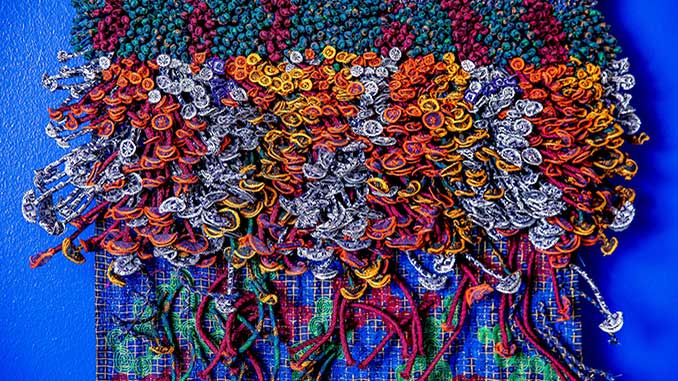 An international textile exhibition exclusive to Melbourne Museum, Sutr Santati: Then. Now. Next. Stories of India woven in thread, opens 13 May 2023.
An international textile exhibition exclusive to Melbourne Museum, Sutr Santati: Then. Now. Next. Stories of India woven in thread, opens 13 May 2023.
Featuring 75 specially commissioned textiles and woven fabrics, the exhibition explores the evolution of Indian culture through the ideals of slow consumerism and the efforts of the collective via the medium of fabric.
Developed to coincide with the 75th anniversary of India’s Independence, includes works from a diverse list of artisans, craftspeople and contemporary designers.
Visitors to the exhibition will discover stories of India’s far and recent past, told via textural pieces showcasing techniques such as embroidery, resist-dyeing, printing, painting, and appliqué.
Lynley Crosswell, CEO and Director of Museums Victoria says the combination of traditional elements and contemporary techniques seen in the featured works is a compelling drawcard for lovers of textiles, design, and Indian art and culture.
“We are excited to host this exquisite exhibition, curated by Lavina Baldota in celebration of 75 years of Indian Independence. This world class exhibition showcases the country’s contemporary artistic and creative landscape and reinforces the value of traditional Indian textiles,” said Lynley Crosswell.
Conceived and curated by Lavina Baldota of the Abheraj Baldota Foundation, Sutr Santati translates in Hindi to the continuity of thread.
“I am very excited for the people of Melbourne to discover India’s diverse textile heritage through the exhibition Sutr Santati: Then. Now. Next. Stories of India woven in thread,” said Ms. Baldota.
“The exhibition combines exceptional works from contemporary designers alongside works from master weavers and intersectional creatives who put their hearts into their craft.”
Key exhibits include Freeway by Chanakya School of Craft, Fungi by Vaishali Shadangule and the Patan Shreenathji patola sari by Gaurang Shah.
Designed by Karishma Swali for Chanakya School of Craft, Freeway commemorates India’s national struggle for freedom in a wall tapestry featuring Mahatma Ghandi at its centre.
Made from organic linen, jute, cotton, raw silk and utilising hand embroidery techniques along with hand couching and knotting, the result is a Sfumato effect – where tones and shades of colours gradually fade into each another.
The concept for Fungi weaves together Shadangule’s research into the natural world and transfers its flow into textile form. The piece’s base fabric is handwoven cotton and silk, made with an original Khun handloom that traditionally makes blouses worn with sarees. The mushroom-like textures are created with its waste scraps, mimicking the life cycles of fungi.
Patan Shreenathji by Gaurang Shah is a handwoven silk patola sari that features the likeness of Hindu God Krishna. Traditionally Krishna’s depiction in woven fabric is uncommon, making this double ikat textile a rare exception. Displayed as a wall hanging, the piece took five years to create from dyeing to the finishing stage.
“India is an important economic and cultural partner for Victoria – and the Sutr Santati exhibition will help to strengthen these already deep connections,” said Minister for Creative Industries Steve Dimopoulos.
Sutr Santati: Then. Now. Next. Stories of India woven in thread
Melbourne Museum, 11 Nicholson Street, Carlton
Exhibition: 13 May – 3 September 2023
Entry fees apply
For more information, visit: www.museumsvictoria.com.au for details.
Image: Fungi, Vaishali Shadangule, Sutr Santati at Melbourne Museum – photo by Tim Carrafa
